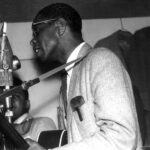For guitar enthusiasts, the allure of a famous guitar goes beyond mere craftsmanship. These instruments are imbued with the spirit of their legendary owners, becoming symbols of musical innovation and rock history. From soulful blues to electrifying rock anthems, certain guitars are inextricably linked to the artists who wielded them, shaping genres and inspiring generations.
Today, we delve into the stories behind some of the most famous and influential guitars in music history and the iconic musicians who made them legendary. Prepare to explore the instruments that have resonated through stadiums, studios, and the hearts of music lovers worldwide.
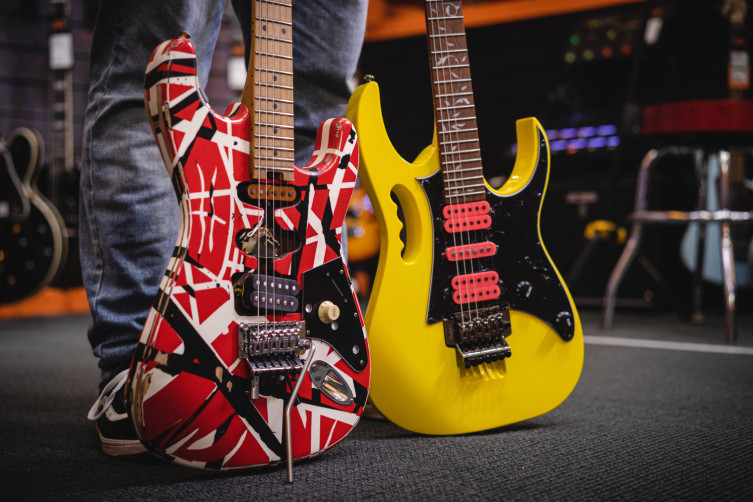 Gibson 'Greeny' Les Paul
Gibson 'Greeny' Les Paul
The Gibson ‘Greeny’ Les Paul: A Tale of Three Guitar Heroes
The ‘Greeny’ Les Paul stands as one of the most storied Gibson Les Pauls ever created. This 1959 Gibson Les Paul Standard, distinguished by its faded Sunburst finish, boasts a remarkable lineage, having been owned and played by not one, but three guitar icons: Peter Green, Gary Moore, and Kirk Hammett.
Peter Green, the original owner, achieved fame with Fleetwood Mac, his distinctive tone partly attributed to a unique wiring anomaly in ‘Greeny’. This quirk produced a more nasal and twangy sound than the typical Les Paul, adding to Green’s signature style.
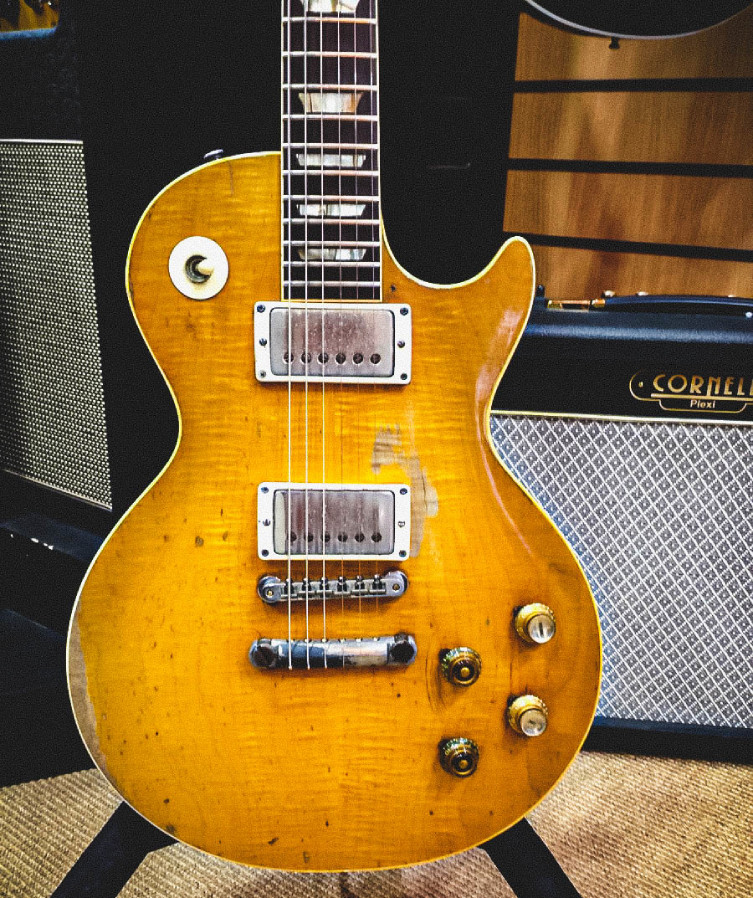 Peter Green with the original 'Greeny' Les Paul
Peter Green with the original 'Greeny' Les Paul
Green later sold ‘Greeny’ to Gary Moore, the Irish blues-rock virtuoso known for his work with Thin Lizzy and his successful solo career. Moore cherished and played ‘Greeny’ for decades, using it on countless recordings and tours, further cementing its legendary status. Eventually, ‘Greeny’ found its way into the hands of Metallica’s Kirk Hammett, who continues to showcase this iconic guitar on stages around the globe, ensuring its legacy endures. The insurance premiums on this guitar must be astronomical, reflecting its priceless value in music history.
Brian May’s Red Special: Built from Scratch, Destined for Stardom
Brian May of Queen is synonymous with a guitar tone as instantly recognizable as his operatic rock compositions. The secret to his sonic signature? The Red Special, a guitar he painstakingly built with his father.
The story of the Red Special is a testament to ingenuity and dedication. Using wood scavenged from an old fireplace, Brian and his father hand-carved and crafted this now-famous electric guitar. Legend has it that even the tremolo arm was initially fashioned from a knitting needle!
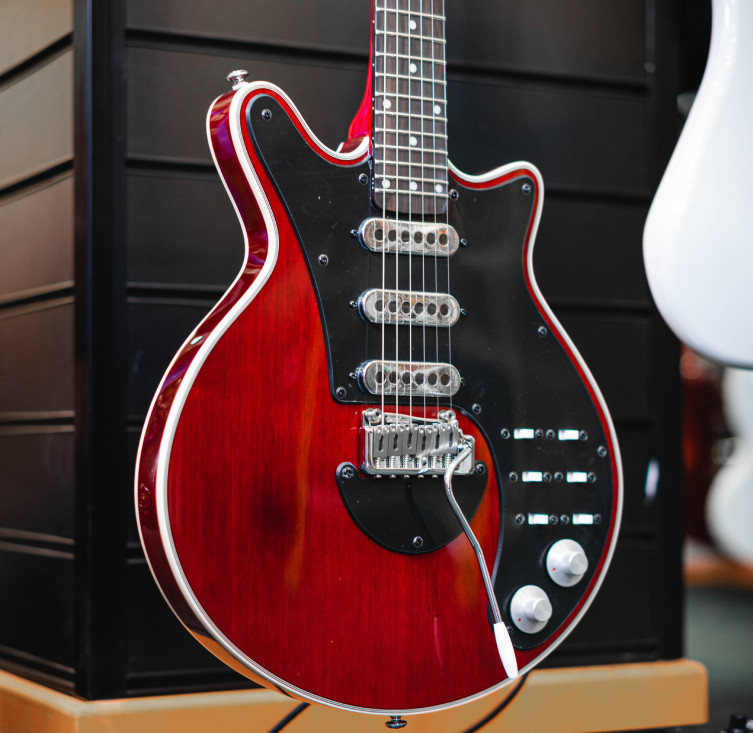 Brian May playing his iconic Red Special guitar
Brian May playing his iconic Red Special guitar
While some components might have been refined over its five decades of service, the Red Special remains May’s primary instrument. Loaded with unique switches and Burns Tri-Sonic pickups – the only purchased components in its construction – the Red Special has defined the sound of Queen, filling stadiums worldwide and gracing every Queen album with its distinctive voice.
Eddie Van Halen’s Frankenstein: The DIY Superstrat that Changed Guitar Playing
Speaking of unique guitar sounds and innovative playing styles, Eddie Van Halen’s Frankenstein guitar immediately comes to mind. While not entirely built from scratch like the Red Special, Frankenstein is a testament to Eddie’s DIY spirit and his quest for the perfect rock guitar.
Eddie assembled Frankenstein from various guitar parts: a Boogie Bodies Strat-style body and a Strat neck he already owned. This Frankensteinian creation became one of the most recognizable guitars in history, mirroring Eddie’s revolutionary approach to guitar playing.
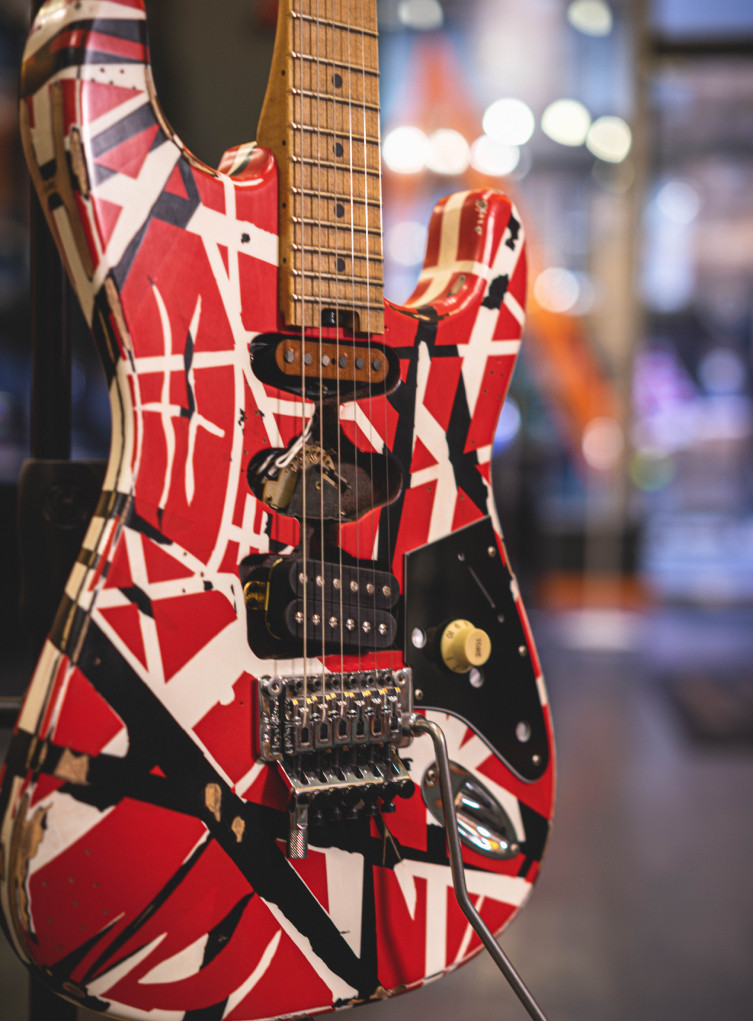 Eddie Van Halen and his Frankenstein guitar
Eddie Van Halen and his Frankenstein guitar
Van Halen repurposed a PAF pickup from his Gibson ES-335, carving out space in the Strat body to accommodate the humbucker. Inspired by David Lee Roth, Van Halen then applied masking tape and spray paint to create the iconic striped finish, solidifying the Frankenstein, or “Frankie,” as a visual and sonic icon.
This single-humbucker Strat configuration with a tremolo bar became the blueprint for the “Superstrat,” dominating the guitar landscape of the 1980s and continuing to influence guitar design today.
Jimi Hendrix’s Monterey Strat: A Fiery Sacrifice at a Legendary Festival
Jimi Hendrix possessed a transformative ability, imbuing every guitar he touched with a special aura. A standard white Stratocaster became the legendary “Woodstock Strat” simply by being in his hands. However, the Monterey Strat, a more personalized and visually striking instrument, holds a unique place in guitar history.
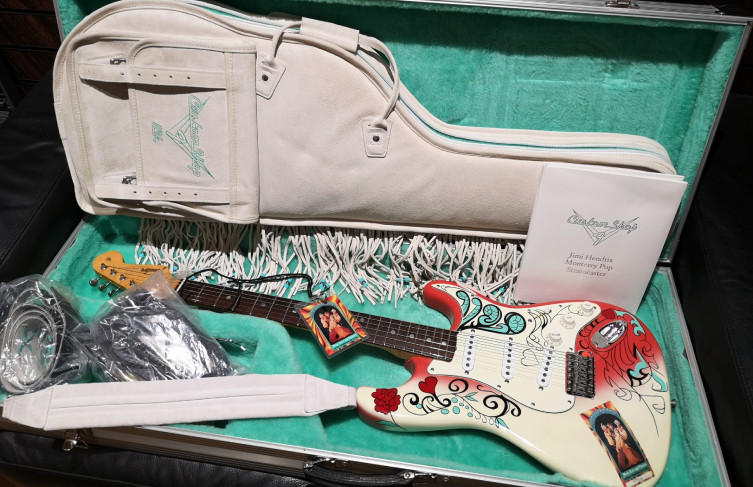 Jimi Hendrix performing with his Monterey Stratocaster
Jimi Hendrix performing with his Monterey Stratocaster
Named after the 1967 Monterey Pop Festival, this Stratocaster is infamous for its dramatic on-stage “sacrifice.” Hendrix, after performing most of his set on a black Strat, switched to this hand-painted white Strat for the finale, “Wild Thing.” In a moment of rock and roll spectacle, he poured lighter fluid on the Monterey Strat and set it ablaze.
While Hendrix reportedly sustained minor burns during this performance, the Monterey Strat incident became a defining moment in rock history, immortalizing both the guitar and Hendrix’s boundary-pushing performance style.
David Gilmour’s Black Strat: The Sound of Pink Floyd’s Masterpieces
Moving from fiery performances to atmospheric soundscapes, David Gilmour’s Black Strat is synonymous with the sonic textures of Pink Floyd’s groundbreaking albums like Dark Side of the Moon and Live at Pompeii. Gilmour, a master of nuance and emotion, favored a relatively unmodified black Stratocaster for much of his iconic work.
Over the years, Gilmour made subtle modifications to his Black Strat, including a shortened tremolo arm, a micro-switch to engage the neck pickup with other pickup selections, and a black single-ply pickguard. These simple changes contributed to one of the most recognizable and influential electric guitar sounds in recorded music history. The Black Strat, in its understated black finish, became the voice of a generation.
Jimmy Page’s ‘Number One’ Les Paul: The Weapon of a Rock Titan
For fans of 1970s hard rock, Jimmy Page wielding his ‘Number One’ Les Paul was an awe-inspiring sight. Paired with his ‘Zoso’ suit and slung low, Page and his Les Paul became the embodiment of rock god status.
‘Number One’ is another 1959 Les Paul Standard, purchased by Page from Eagles guitarist Joe Walsh in 1969. By the time Page acquired it, the neck had already been shaved to a thinner profile. Page further modified the guitar, adding a push-pull phase switch and removing the nickel cover from the bridge pickup, contrary to some rumors of a pickup swap.
‘Number One’ became Jimmy Page’s main guitar throughout Led Zeppelin’s reign, contributing to some of the most iconic riffs and solos in rock history. It remains his go-to instrument to this day.
Stevie Ray Vaughan’s ‘Number One’ Stratocaster: Blues Fury from Texas
Another ‘Number One’ on our list, Stevie Ray Vaughan’s Stratocaster, affectionately nicknamed “Number One” or “First Wife,” is instantly recognizable to blues aficionados. SRV, a pivotal figure in contemporary blues, left an indelible mark on guitar playing, influencing countless musicians who followed. His untimely passing at a young age only adds to the mystique surrounding his legacy and his iconic instrument.
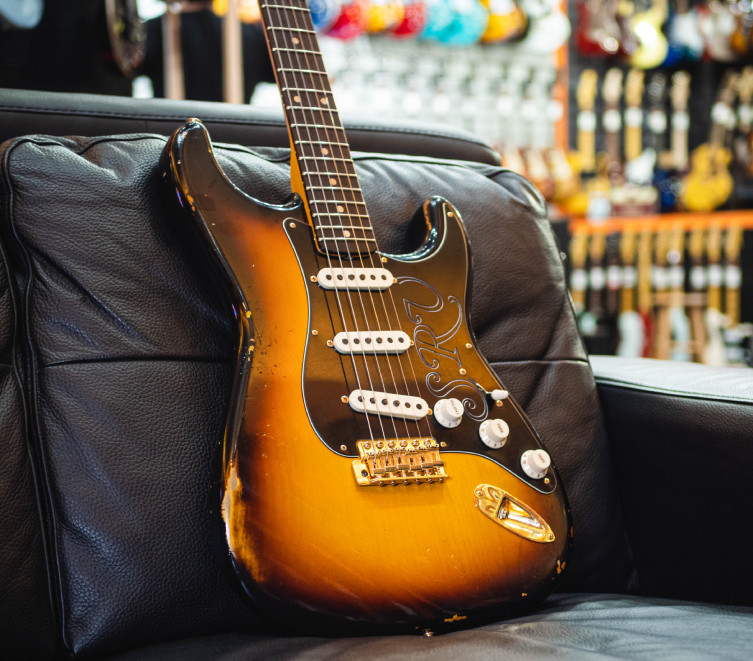 Stevie Ray Vaughan playing his beloved 'Number One' Stratocaster
Stevie Ray Vaughan playing his beloved 'Number One' Stratocaster
‘Number One’ was a composite guitar, assembled from a 1963 Strat body, a 1962 neck, and 1959 pickups. Vaughan added a black pickguard and a left-handed tremolo, and famously stated that the guitar was “rebuilt more often than a custom Chevy,” reflecting its constant use and modifications. This well-worn Strat became the vehicle for Vaughan’s fiery blues playing, a testament to his raw talent and passion.
Billy Gibbons’ Pearly Gates: A Blessed Les Paul with Texas Tone
Staying in Texas, we turn to Billy Gibbons of ZZ Top, a master of tone and sunglasses. Gibbons is the proud owner of Pearly Gates, the third legendary 1959 Les Paul Standard on our list.
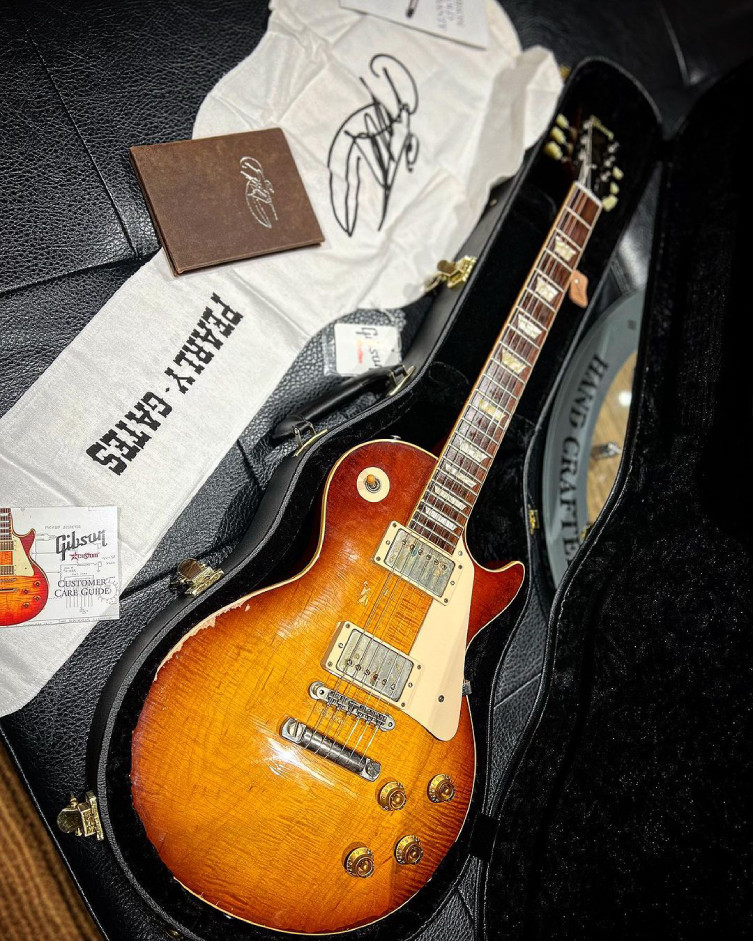 Billy Gibbons holding his famous 'Pearly Gates' Les Paul
Billy Gibbons holding his famous 'Pearly Gates' Les Paul
The acquisition story of Pearly Gates is as colorful as Gibbons himself, involving a Hollywood starlet, a hot rod, and a farmer with a guitar stashed under his bed. This legendary Les Paul has been the cornerstone of Gibbons’ signature tone, a benchmark for guitar sound.
Combined with his signature gauge 7 strings, a Mexican peso used as a pick, and his trademark headwear, Pearly Gates is integral to Billy Gibbons’ unique and powerful guitar voice.
Steve Vai’s Evo: An Ibanez Masterpiece for a Virtuoso
Steve Vai, a guitarist known for his technical brilliance and innovative techniques, needed a guitar that matched his extraordinary abilities. Ibanez rose to the challenge, collaborating with Vai to create his signature model, the Ibanez JEM. Vai’s personal favorite among the prototypes was “Evo,” short for Evolution, also the name he gave to his signature DiMarzio pickups.
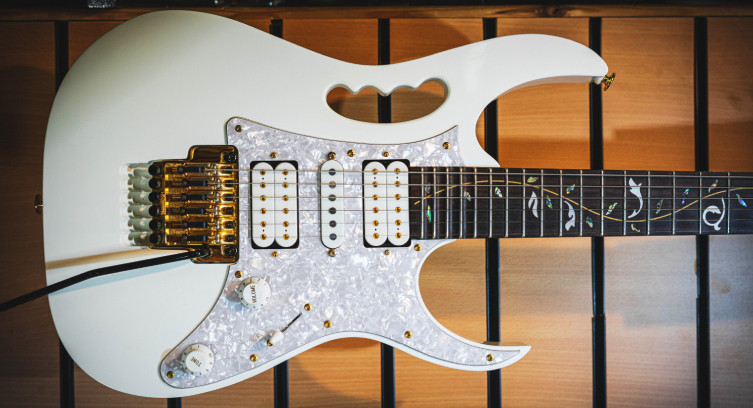 Steve Vai playing his Ibanez Evo guitar
Steve Vai playing his Ibanez Evo guitar
Evo became the template for all subsequent JEM models, featuring distinctive elements like the “monkey grip” handle, deep tremolo routing, and elaborate “tree-of-life” inlays. While some might see the JEM as an evolution of the Ibanez RG, it’s actually the other way around. The JEM’s bold design was later simplified by Ibanez for mass production as the RG series. Evo remains Steve Vai’s primary stage guitar, a testament to its playability and unique character.
Tom Morello’s ‘Arm the Homeless’: Political Fury Through a Modified Guitar
Tom Morello of Rage Against the Machine is renowned for his sonic experimentation and politically charged lyrics. His “Arm the Homeless” guitar is as unique and impactful as his playing style. This heavily modified guitar, kept in standard tuning due to its locking tremolo, is a key instrument in Morello’s sonic arsenal, alongside his drop-D tuned Fender Telecaster.
“Arm the Homeless” has undergone numerous transformations, with over a dozen pickup changes, multiple necks, and various bridges. In fact, the only original part from the Performance Guitars USA instrument is the alder body. Featuring a Floyd Rose tremolo, an “aircraft switch,” and EMG pickups, including a single-coil EMG H in a humbucker housing in the neck position, this guitar is a sonic laboratory.
The guitar’s name and the iconic hippopotamus stickers are a statement in themselves. As Morello explains, “I liked the juxtaposition of that kind of provocative and militant situationist slogan with those four smiling hippopotamuses all facing in one direction.” “Arm the Homeless” embodies Morello’s blend of musical innovation and social commentary.
The Enduring Legacy of Famous Guitars
The guitars we’ve explored are more than just instruments; they are cultural artifacts, imbued with the spirit and history of their legendary owners. From Clapton’s ‘The Fool’ SG to Buddy Guy’s polka dot Strat and Billy Duffy’s White Falcon, the connection between guitarist and guitar is a powerful and enduring one.
Interestingly, many of these iconic guitars are not pristine museum pieces. A significant number have been modified, rebuilt, or pieced together, reflecting the artists’ desire to tailor their instruments to their unique playing styles. This underscores a crucial point: great musicians often push the boundaries of their instruments, seeking to personalize and optimize them for their individual voices. This spirit of experimentation and customization is a valuable lesson for any aspiring guitarist. While owning a vintage instrument is appealing, the true inspiration lies in finding your own voice and shaping your instrument to match your musical vision. Unless, of course, you happen to own a pristine 1959 Les Paul Standard – in that case, perhaps keep it as it is!

